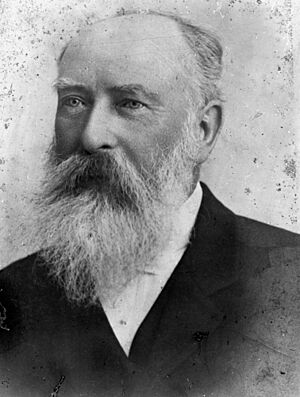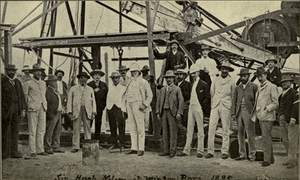Hugh Nelson (Australian politician) facts for kids
Quick facts for kids
Sir Hugh Nelson
KCMG,
|
|
|---|---|
 |
|
| 11th Premier of Queensland | |
| In office 27 October 1893 – 13 April 1898 |
|
| Preceded by | Sir Thomas McIlwraith |
| Succeeded by | Thomas Joseph Byrnes |
| Constituency | Murilla |
| 17th Treasurer of Queensland | |
| In office 27 March 1893 – 2 March 1898 |
|
| Preceded by | Thomas McIlwraith |
| Succeeded by | Robert Philp |
| Constituency | Murilla |
| Member of the Queensland Legislative Assembly for Northern Downs |
|
| In office 7 September 1883 – 28 April 1888 |
|
| Preceded by | George Thorn Jr |
| Succeeded by | Seat abolished |
| Member of the Queensland Legislative Assembly for Murilla |
|
| In office 28 April 1888 – 13 April 1898 |
|
| Preceded by | New seat |
| Succeeded by | William Moore |
| Member of the Queensland Legislative Council | |
| In office 13 April 1898 – 1 January 1906 |
|
| Personal details | |
| Born | 31 December 1833 Kilmarnock, Scotland, UK |
| Died | 1 January 1906 (aged 72) Toowoomba, Queensland, Australia |
| Resting place | Drayton and Toowoomba Cemetery |
| Political party | Ministerialist |
| Spouse | Janet McIntyre |
| Relations | William Nelson (father) |
| Occupation | Dairy farmer, Sheep breeder, Station Hand |
Sir Hugh Muir Nelson (born December 31, 1833 – died January 1, 1906) was an important Australian politician. He served as the Premier of Queensland from 1893 to 1898. This means he was like the leader of the government for the state of Queensland.
Contents
Early Life and Career
Hugh Nelson was born in Kilmarnock, Scotland. His father was William Lambie Nelson. Hugh went to school at the Edinburgh High School. He also started studying at Edinburgh University.
In 1853, Hugh moved to Queensland, Australia, with his father. They settled in Ipswich. Hugh first worked in a business office. Later, he started a life working with livestock on a farm near Ipswich.
He then moved to the Darling Downs area to manage a large farm called a station. In 1870, he married Janet McIntyre. After that, Nelson took over Loudon station in the Dalby district.
His father, William Lambie Nelson, was elected to the first Queensland parliament in 1860. However, he could not keep his seat because he was a minister of religion.
Political Journey
In 1880, Hugh Nelson became a member of the Wambo board. This board helped manage local areas. His strong personality and intelligence quickly made him the chairman.
On September 7, 1883, he was elected to the Legislative Assembly of Queensland. He represented the Northern Downs area. After some changes to the voting areas in 1887-1888, he became the member for Murilla. He held this position until April 13, 1898.
In June 1888, he became the Secretary for Railways. This was part of the government led by Thomas McIlwraith. He kept this job when Morehead took over from McIlwraith.
When Griffith became Premier, Nelson was chosen to lead the opposition party. The opposition is the main party that is not in power.
Becoming Premier
In March 1893, Griffith left his role to become a chief justice. Hugh Nelson then formed a partnership with McIlwraith's group. This created a new government. Nelson took on two important jobs: Treasurer (managing the state's money) and vice-president of the executive council.
In October 1893, Hugh Nelson became the Premier of Queensland. His government lasted for four and a half years. For the last three years, he was also the chief secretary.
Key Achievements
Nelson was given the title K.C.M.G. in 1896. This is a special honor from the British Crown. He also joined the privy council during his visit to England in 1897. This was during the Diamond Jubilee celebrations for Queen Victoria.
He did very important work as Treasurer during a difficult time. There was a financial crisis in 1893, which caused economic problems. Nelson helped Queensland recover from this.
In April 1898, when a new government led by Byrnes took power, Nelson became the president of the Queensland Legislative Council. This is another part of the state's parliament. In 1903, he became the lieutenant-governor. His good looks, polite manner, and grace made him very suitable for these roles.
Nelson understood people well and was a skilled politician. He had a good grasp of how the government worked and understood money matters. People liked him because he was friendly. While he wasn't a great speaker, his practical common sense always made people listen to him.
He was against the idea of Queensland splitting into smaller states. He also didn't support the idea of Australia becoming a single federation at first. He showed great strength during a shearers' strike in 1894. However, his most important work was as Treasurer, where he guided the state out of financial trouble.
Later Life and Legacy
Sir Hugh Nelson passed away in Toowoomba on January 1, 1906. He was survived by his wife, Lady Nelson, two sons, and three daughters. He was given a special state funeral. He was buried in the Drayton and Toowoomba Cemetery.
Images for kids



